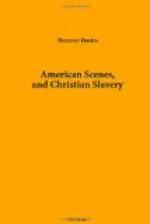The next day we went to see the “First Congregational Church” in this place—that in which Dr. Hawes ministers, together with the old burying-ground attached to it. This was the original church formed by the first settlers, who in 1636 came from Braintree in Essex, bringing their pastor the Rev. Thos. Hooker along with them. Of him it is said, that he appeared in the pulpit with such dignity and independence as if “while engaged in his Master’s work he could put a king in his pocket.” Here is his tomb, dated 1647. Two eventful centuries have rolled away, during which this church has had only nine pastors; all of whom, except the last, Dr. Hawes, who still survives, died in their charge, and were interred in this place. Interments here are no longer continued; but an old bachelor, of independent means, a descendant of the Pilgrims, spends nearly the whole of his time “among the tombs” of the fathers and prophets, and, con amore, keeps the ground and the graves in the most beautiful order.
Our host Mr. Hosmer took us to see the new burying-ground outside of the city. Here the Catholics and the coloured people had each a parcel of ground allotted for themselves,—the former because they would not, and the latter because they should not, mingle their dust with that of other people!
On our way back I said to my friend, “How was it that neither Mr. Pennington nor any of his people (coloured congregation) were at the meeting last night? I should have thought they would have come to hear about their own brethren in Guiana.” “Why,” he replied, “the fact was I did not send a notice to them on Sunday: I knew that in the ‘Fourth’ Church they would have been scattered all over the place; it would have been so unpleasant, and talked of for months.” Here then was a man of a large heart, a friend of missions and of all that is good, one who seemed as if he could embrace the whole world in his sympathies, under the dominion of a prejudice you would have expected him to scorn!
At Hartford lives Mrs. Sigourney, the graceful American poetess. She is a pious member of one of the Congregational Churches. Mr. Hosmer kindly took us to call upon her; and we were greatly pleased with our brief visit.
At 2 P.M. we left with regret this delightful little city, and shall always cherish a grateful remembrance of the Christian kindness and hospitality with which we were treated. In all the States we met with nothing to be compared, in all that was pleasing, to the two cities of Connecticut—New Haven and Hartford.
In passing, on our way to Boston, through Worcester in Massachusetts, I cast a hurried glance at every place that looked like a smithy, wondering whether it was there that Elihu Burritt had wielded his forge-hammer and scattered his “sparks from the anvil.”




